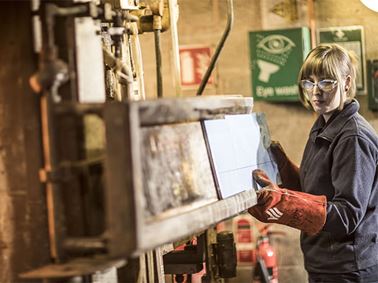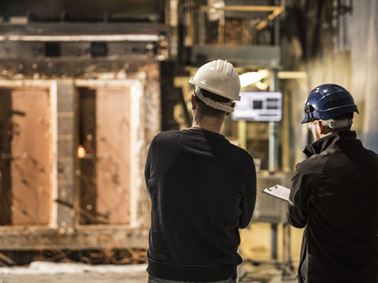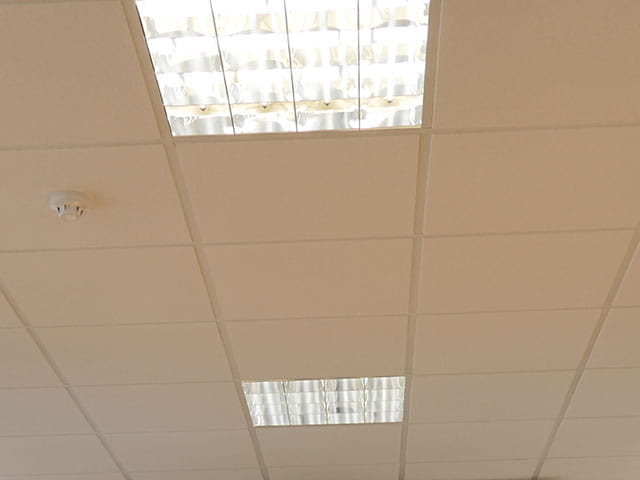Floor & Suspended Ceilings Testing
Warringtonfire can provide reaction to fire and fire resistance testing for all your floor and suspended ceiling systems. Floor and suspended ceiling systems are often tested together as, when in-situ in multi-storey buildings, they provide essential compartmentation in the event of a fire.
Why do I need to test my floor and suspended ceiling systems?
These systems play a crucial role in real-life fire scenarios. The compartmentation afforded by floor and suspended ceiling systems following proper testing, certification, installation and maintenance processes, allows occupants time to escape or enables the fire brigade to enter without fear of collapse.
Global building regulations set out detailed requirements for these systems, which manufacturers must adhere to.
What testing will my floor and suspended ceiling systems require?
Floor and suspended ceiling testing shows how the systems and components, working together, will prevent the structure from collapsing or control how the fire spreads from one compartment to another. Because of the crucial role these systems play in real-life fire scenarios, the fire tests they are subjected to are rigorous.
Fire resisting floors and suspended ceilings require testing in accordance with British or European Standards to BS 476: Part 21: 1987 and/or EN 1365-2: 2014 and Australian Standard AS 1530.4 Section 4.
During this testing, specific components and materials from the floor and/or suspended ceiling will be tested to see how they perform under standardised fire test conditions. The floor is exposed to a fire from below, and it is evaluated against the structural adequacy, integrity and insulation criteria of the standard.
Loadbearing concrete floors supported by steel beams and protected with a suspended ceiling should be tested or assessed to BS 476: Part 23: 1987 or EN 1365-2: 2014.
In the case of tests conducted to the EN series of tests, the performance of the element can be classified according to EN 13501-2: 2016.
With reaction to fire testing, BS 476: Parts 6 and 7 tests the combustibility of the products under the fire propagation test and how the fire develops on the product under the surface spread of the flame test (AS 1530.1 and AS 1530.3 tests in Australia). Find out more about our reaction to fire testing for the construction industry.
With floor and suspended ceilings, the test evidence is only valid if the systems are installed as they are intended. To find out more about the certification of installers, click here.
What is a suspended ceiling?
A suspended ceiling is an additional ceiling that hangs from the structural floor slab above; this creates a void between the floor above the ceiling and the top of the suspended ceiling. They can be found in a variety of different buildings, from commercial properties to schools and hospitals. The space a suspended ceiling provides can conceal wires, HVAC services, security features, detectors and sound and light fittings, as well as any active fire protection measures that would otherwise be on display. A suspended ceiling can also give a better acoustic performance, provide energy saving costs and benefit and, of course, give additional passive fire protection to a room/building.
Suspended ceilings are required to give a period of fire resistance and undergo testing to prove this; however, this fire resistance could be compromised if not installed and maintained correctly.
Passive fire protection from floors and suspended ceilings
Floors and suspended ceilings are classed as passive fire protection products, as they are built into the main fabric of a building and serve as an essential tool to stop fire spread. Also known as fire barrier systems, when tested, certified and installed correctly, they can provide up to 4 hours of fire protection (dependent on test evidence and installation) and provide what is known as compartmentation in a fire scenario.
The horizontal compartmentation of suspended ceilings is extremely important because it can slow down the spread of fire and hot gasses from one floor to another, allowing more time for evacuation.
Floors and suspended ceilings – what the building regulations say
The fire rating of floors and suspended ceilings are an integral part of the fire safety strategy in multi-storey buildings, yet the different demands on these systems can vary depending on the type of room and structure they are installed in. A fire rated ceiling may only be necessary over escape routes or where compartmentation is required.
In the UK, the national building regulations set out detailed requirements for these systems, which is generally mirrored across the globe in other local laws, including the National Construction Code (NCC) of Australia.
Two requirements of floors and suspended ceilings are:
- Suspended ceilings must only make a negligible contribution to the fire development, the spread of flame, and smoke production.
- Suspended ceilings must hold their structural integrity during the early stages of the fire so that evacuation and rescue operations can be completed.
In addition, the Australian NCC requires testing to determine the ability of a ceiling system to insulate the space between the ceiling and the roof or floor above to limit the temperature rise in these spaces. This is known as the Resistance to the incipient spread of fire.
These requirements are tested during the fire resistance testing process. It is important to note that the entire suspended ceiling system is tested when determining the above conditions. It is not enough to determine how the materials used in themselves react to a fire situation. To be determined safe for use, the whole system is tested including all the fixtures, fittings and materials, so correct installation and maintenance are essential to keep these products working effectively.
To find out more about how Warringtonfire can help you with your floor and suspended ceiling testing and certification, please contact us at the below laboratory.Contact Details and Related Services
Gent
Contact us today on: +32 9293 0081
High Wycombe
Contact us today on: +44 (0)1494 840 780
Melbourne
Contact us today on: +61 397671000
Warrington
Contact us today on: +44 (0)1925 541 267
Articles and Blogs
Warringtonfire has a library of technical articles and blogs to help you better understand our services and how we can help you.
Our Services
SERVICES

Reaction to Fire
Find out how we help our customers to evaluate ignition, flame spread, heat release, smoke generation and toxicity for their materials, products and systems.

Fire Engineering
Find out more about how we can offer a range of fire inspection and engineering to complement our other services.

Certification
Find out how about our a range of fire and non-fire third party certification to complement our other services.
